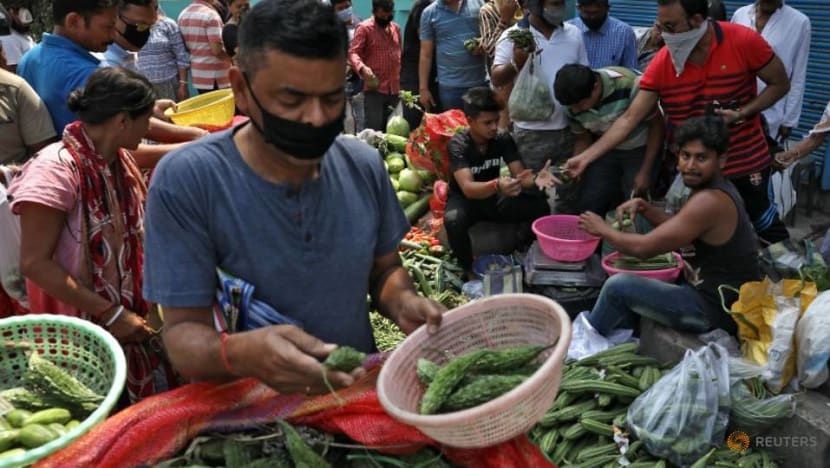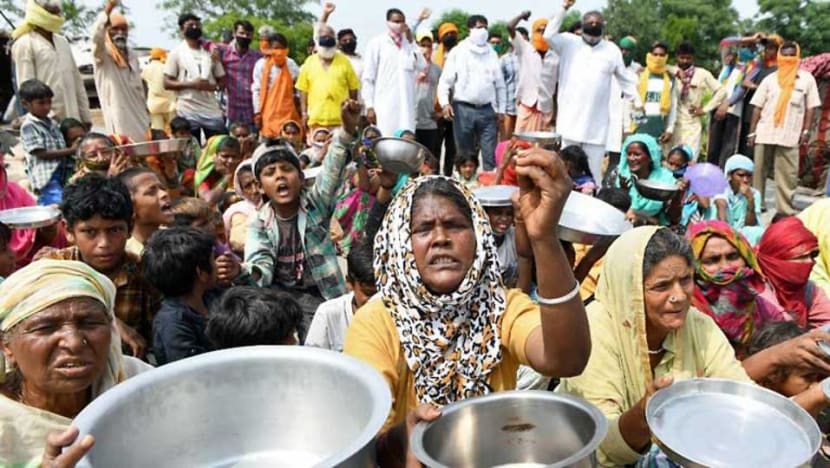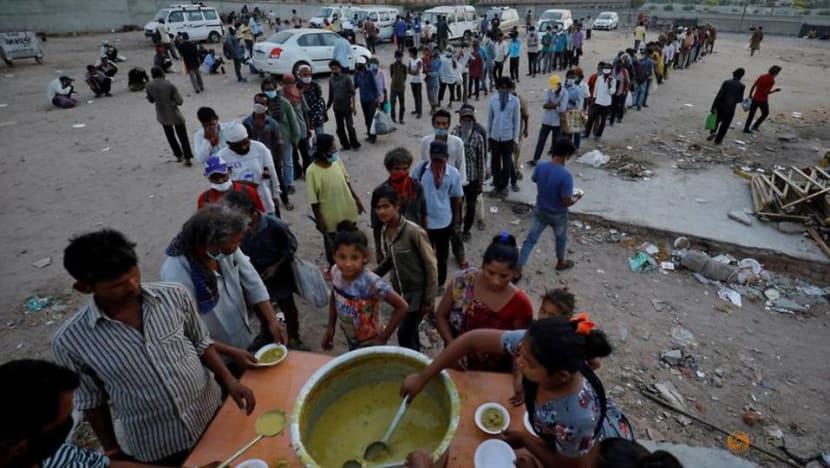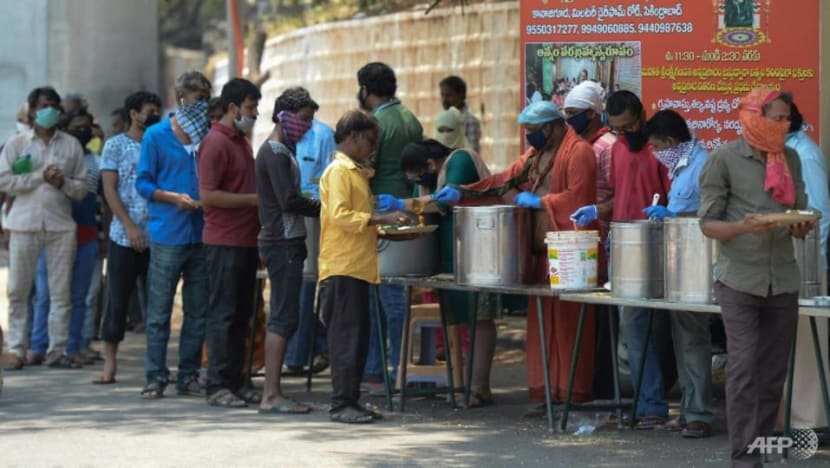commentary Commentary
Commentary: COVID-19 is leaving India hungry in more ways than one
Many are faced with the cruel trade-off between defying the lockdown and catching the virus, or remaining at home and seeing their scanty food stocks dwindle, says an observer.

People buy vegetables from roadside stalls before the start of the lockdown by West Bengal state government, to limit the spreading of coronavirus disease (COVID-19), in Kolkata, India March 23, 2020. (Photo: REUTERS/Rupak De Chowdhuri)
GENEVA: India is one of the world’s largest food producers.
Ironically, the country is also home to the largest population of hungry people and one-third of the world’s malnourished children. The Global Hunger Index ranks India 102nd among 117 countries.
The course of the COVID-19 pandemic has made these conditions worse. The virus has disrupted global and local food systems, and India’s poor and hungry are being affected worse than ever.
Earlier this year, before the pandemic, India was readying itself to fill any potential trade vacuums caused by countries considering trade restrictions on China that included foodstuffs like rice, onions, potatoes, vegetables, mangoes and honey.
READ: Commentary: From farmers to supermarket clerks, a new kind of essential worker has emerged
READ: Commentary: China is not that dependent on trade for growth
India was also looking to export US$100 billion worth of agricultural products by 2025, tapping into new markets in Latin America and Oceania.
And it was expecting a record harvest of 295.7 million metric tonnes this year.
HOW COVID-19 SHAKES FOOD SYSTEMS
By March, when COVID-19 cases were first detected in the country, the situation took a 180-degree turn. A hasty nationwide lockdown shook the country, including its fragmented and fragile food systems and supply chains.
The Food and Agricultural Organisation (FAO) estimates nearly 40 per cent of the food produced in India is lost or wasted every year due to inefficient supply chains. A lack of cooling and storage facilities in India also means 20 per cent of the entire food production gets lost before it reaches the marketplace.
The pandemic amplified the vulnerabilities of the national food system. It has disrupted local, regional and national supply chains, adding to the impacts of the country’s food waste problem.

Small growers have had to sell their produce at a loss, if they have been able to sell it at all. Onions are rotting in containers, a consequence of plunging catering services.
The lockdown measures resulted in severe labour shortages, delaying the mid-April wheat harvest by two weeks.
In the potato-producing states of Uttar Pradesh and West Bengal, increased demand from returning migrant workers pushed up prices by 9 per cent at the wholesale level and 11 per cent in retail.
Imports of food have also stalled due to the COVID-19 pandemic. Partial port operations and the closure of roads and air cargo have hampered the movement of grains across the country.
READ: Commentary: India’s struggle with COVID-19 could get much worse
READ: Commentary: Farmers hold key to feeding Asia amid COVID-19 restrictions
COVID-19 DISINFORMATION
Disinformation amid the pandemic has now emerged as a wild card.
In big cities, chicken and mutton prices have gone up by 75 per cent. In places like Maharashtra, the sector has taken a US$3 billion blow as messages circulating on social media have spread rumours that COVID-19 can be transmitted through chicken meat.
To make matters worse, rice cultivation has come under threat from a locust invasion, which is causing havoc in East Africa and has already reached neighbouring Pakistan.
Changing weather conditions and local environmental degradation have created the ideal conditions for these voracious pests to breed. In hours, a 1 sq km swarm containing about 40 million locusts eats as much food in one day as 35,000 people. This can devastate local food supplies.
READ: Commentary: The wonder of clear skies and returning wildlife is our new climate problem
IMPACT ON FARMERS
In a race against time, producers are trying to work through the rice-sowing season amid severe labour shortages. Farmers are stranded, unable to travel to the villages where they would normally be employed for the season.

These logistical constraints and partial lockdowns hampering workers’ movement have increased the pressures on already stretched food markets.
For these workers, the pandemic and the government response have shaken their food production and access to income. People working in the informal sector account for 90 per cent of India’s labour force.
Without the prospect of earning a steady income, let alone save for uncertain times, it was clear the measures to contain the health emergency would affect those in agriculture, construction and services the hardest.
READ: Commentary: COVID-19 affects the choice and price of food available to us
As people have lost their jobs and meagre incomes, food insecurity has skyrocketed, and nutrition security worsened among the already vulnerable. Close to 38,000 relief camps are providing basic meals to 16 million people every day in India during this pandemic.
Many people were faced with the cruel trade-off between defying the lockdown and catching the virus or remaining at home and seeing their scanty food stocks dwindle.
For most, however, the more tangible dilemma was between starving in the city or continuing to be malnourished in their home villages.
READ: Why in a cheap food paradise, some Singaporeans are still going hungry
ATTEMPTS TO SAVE INDIA
Indian people know hunger well. Some 196 million people are undernourished, and malnutrition is the top cause of death and disability. It is clear that food security remains a serious challenge.
Some regional initiatives have aimed to temporarily alleviate the situation.
In Mumbai, the newly founded Hunger Collective, a collaborative movement to help people secure their basic needs during the crisis, is distributing food rations to those in need.

Organisations focused on data and information communication technology, like Impactree, CI Metrices and EDUCO, have joined forces to track migrant workers stranded in Mumbai. These groups send this information to NGOs distributing food in the communities where these labourers are located.
The collective has donated personal protective equipment, or PPE, to health workers. It also raised funds to secure safe train passage to the state of Tamil Nadu after 7,000 migrant workers were stranded in the state of Maharashtra.
The extent of this civil society mobilisation, however, cannot provide a safety net for the 60 to 80 million workers who migrate between states. This requires a government-led effort of Indian proportions.
READ: Commentary: This new Ministry of Sustainability and Environment looks pretty promising
READ: Commentary: China and India – the region’s twin growth engines – are stuttering
LESSONS FROM INDIA
COVID-19 is posing unprecedented challenges for governments, businesses and individuals all over the world.
For the world’s biggest democracy and the largest population of hungry people, current local and national economic and social assistance measures are a good start.
This is, however, only a small part of a long journey to establish broad, inclusive and equal livelihoods and food systems that can start closing the caloric and nutrient gap for the poor. This truism holds for all countries, regardless of GDP levels.
The situation in India has been a wake-up call on the need to reconfigure food systems and the millions of livelihoods and lives depending on them.
BOOKMARK THIS: Our comprehensive coverage of the coronavirus outbreak and its developments
Download our app or subscribe to our Telegram channel for the latest updates on the coronavirus outbreak: https://cna.asia/telegram
Andrea Biswas Tortajada is Doctoral Student at the Graduate Institute, Geneva. Cecilia Tortajada is Senior Research Fellow at the Lee Kuan Yew School of Public Policy, NUS. This commentary first appeared on The Conversation.














